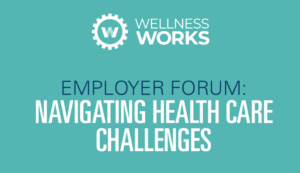
Southeast Michigan employers joined the Employer Forum: Navigating Health Care Challenges presented by the Detroit Regional Chamber and Blue Cross Blue Shield of Michigan to explore access, cost, and strategies for managing workplace mental health and holiday-related stress.
The University of Michigan Depression Center’s workplace mental health team discussed how employers can effectively support their workforce through COVID-19-related mental health challenges.
James Grant, senior vice president and chief medical officer for Blue Cross Blue Shield of Michigan discussed access to healthcare amid the pandemic and gave an update on the COVID-19 vaccine.
COVID-19 vaccine update
One vaccine has already received Emergency Use Authorization from the Food and Drug Administration, while another is expected to receive the same approval later this week. The COVID-19 vaccine will be no cost for patients. The federal government is covering the cost of the vaccine and insurance carriers are required to cover the cost of administering the vaccine.
There are still may unknowns:
-
- The time it will take to immunize everyone who wishes to receive the vaccine.
- The duration of immunization for those receiving the vaccine.
- The long-term implications and side-effects.
It remains unclear when life will go back to normal.
“We are going to have to see our case numbers drop, hospitalizations decrease, and how effective vaccination is,” said Grant.
“COVID-19 introduced new headwinds to the continuously changing healthcare landscape,” explained Grant. This new challenge allowed new care delivery models to thrive.
Prior to March, behavioral health was growing popular among employers as a means of improving employee well-being and controlling health care costs. Approximately $16.8 billion is lost in productivity due to mental illness each year, with more than 200 million workdays missed, according to Blue Cross Blue Shield Association.
“Behavioral health is part of who we are and in our culture. It’s important we remain physical and mentally well,” said Grant.
Due to challenges related to the pandemic, including isolation, business shutdowns, and overwhelmed hospitals, telehealth services skyrocketed.
“Within the first month, we saw an increase in providers delivering telehealth, from just under 10% pre-pandemic to greater than 85% of providers delivering telehealth after the outbreak,” said Grant.
When can telehealth services be used?
Not all services can be delivered through telehealth, but some of the most common types of telehealth interactions include:
-
- Sick visits and follow-up/routine visits.
- Medication refills.
- Behavioral health appointments.
- Care management.
- New patient intake/education.
- Sometimes annual wellness visits.
- COVID-19 counseling.
- Support groups.
- Consultations.
Telehealth services reduce barriers to care for many employees making telehealth an effective tool for helping employees stay mentally well amid the pandemic. While organizations can benefit from promoting telehealth care options, employees should still attend their regularly scheduled preventative exams and cancer screenings.
“Delaying care can be more detrimental than your risk of being exposed to COVID,” said Grant. “Hospitals and clinics have precautions in place to keep you safe during your visit.”
Data indicates rates of depression and anxiety have tripled due to effects of the pandemic. In addition, racial unrest and political tension are contributing to poorer mental health overall. The University of Michigan Depression Center’s workplace mental health team discussed how employers can effectively support their workforce through COVID-19-related mental health challenges
“People spend one third of their lives working, so this makes the workplace an ideal space for initial outreach, prevention, and treatment,” said Danielle Taubman, program evaluation specialist at the University of Michigan Depression Center.
To effectively address mental health challenges in the workplace, employers must:
-
- Foster a mentally healthy workplace culture.
- Be able to recognize and respond to signs of mental health conditions in employees.
What are signs an employee may be struggling with a mental health condition?
This will depend on the individual and the condition, but common signs include:
-
- Changes in appearance and self-care.
- Difficulty working with others.
- Quick to anger.
- Withdrawing socially.
- Frequently late or missing work.
- Poor work performance.
- Being more negative.
How can employers foster a mentally healthy workplace?
- Open and frequent communication: Employers should make a point to check in and be available when employees need to talk. Frequent communication can help managers detect changes in an employee’s mood or behavior.
“The more you know about your employees on a good day, the better you will be able to notice when something is off,” said Taubman.
- Lead with compassion and empathy: Managers should acknowledge the impact mental health has in the workplace and let employees know that it’s normal and okay to struggle at times.
- Share resources: Remind employees of available mental health resources such as the company’s Employee Assistance Program. It is important to make sure these programs are easily accessible to employees online.
How to cope with holiday stress and isolation this winter:
Even without a pandemic, the holidays can be a difficult time for many employees. Taubmaen recommends:
-
- Reaching out if you feel lonely.
- Setting realistic expectations for the holidays.
- Acknowledging that this is a stressful time.
- Taking time away for yourself to do an activity you enjoy.
- Maintaining self-care and healthy habits.
If managers can communicate frequently, lead with compassion, and share mental health resources, they will be supporting employee mental health during these challenging times.